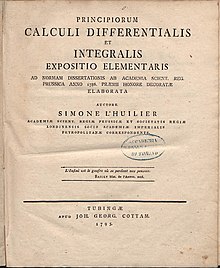Simon L'Huilier
Simon Antoine Jean L'Huilier (born April 24, 1750 in Geneva ; † March 28, 1840 , ibid) was a Swiss mathematician . Among other things, he became known for his contributions to differential calculus .
life and work
L'Huilier was the son of Laurent Lhuilier and Suzanne-Constance Matte. The ancestors of the family had to flee to Geneva because of the Huguenots because of the repeal of the Edict of Nantes in 1691.
He showed himself to be mathematics at an early age, so that he turned down an inheritance that he would only have received on condition that he had joined the clergy. In Geneva he was tutored by Louis Bertrand and Georges-Louis Le Sage . Le Sage also got him a job as a private tutor.
In 1775, Christoph Friedrich Pfleiderer wrote out an award publication on a subject in physics. Le Sage advised his student L'Huilier to take part, which he did, but he did not choose a physical, but a mathematical topic. L'Huilier won the award and was able to publish a mathematical textbook in Poland in 1780. Adam Kazimierz Czartoryski invited him to come to Poland and teach his son, which L'Huilier accepted. He stayed in Poland for 11 years and devoted himself to mathematical studies and published many writings.
In 1784 the Berlin Academy of Sciences announced a competition on the mathematical concept of infinity. L'Huilier won the competition, and in 1786 his award script was published. In his work he introduced many expressions of differential calculus that are still in use today, such as B. the term lim - which by the way was already used by him in his Polish textbook from 1780.
From 1789 he stayed for some time with his friend Pfleiderer in Tübingen , who held a chair for mathematics there. L'Huilier was offered a chair in mathematics in Leiden, but he turned it down. From 1795 he became a professor of mathematics at the Academy of Geneva and he held this position until his retirement in 1823.
In 1795 he married Marie Cartier and had two children with her. He was a member of the Royal Society , the Academies of Berlin , Göttingen (since 1795) and St. Petersburg , was Rector of the Academy of Geneva and also for some time President of the Legislative Council in Geneva.
In 1811 he wrote a work with counterexamples of polyhedra, for which Euler's polyhedron theorem does not apply, published in 1813 in abridged form in the Annales des Mathématiques by Joseph Gergonne . These included polyhedra with holes and other cases which later found their topological interpretation in the formula for the Euler characteristic .
Web links
- Rudolf Wolf: Simon Lhuilier from Geneva . In: Biographies on the cultural history of Switzerland . tape 1 , 1858, p. 401-422 .
- John J. O'Connor, Edmund F. Robertson : Simon L'Huilier. In: MacTutor History of Mathematics archive .
- Eric Weisstein: L'Huilier's Theorem . In: MathWorld (English).
Individual evidence
- ↑ Holger Krahnke: The members of the Academy of Sciences in Göttingen 1751-2001 (= Treatises of the Academy of Sciences in Göttingen, Philological-Historical Class. Volume 3, Vol. 246 = Treatises of the Academy of Sciences in Göttingen, Mathematical-Physical Class. Episode 3, vol. 50). Vandenhoeck & Ruprecht, Göttingen 2001, ISBN 3-525-82516-1 , p. 150.
- ↑ David Richeson The polyhedral formula , in Bradley, Sandifer Euler , Elsevier 2007
| personal data | |
|---|---|
| SURNAME | L'Huilier, Simon |
| ALTERNATIVE NAMES | L'Huilier, Simon Antoine Jean |
| BRIEF DESCRIPTION | Swiss mathematician |
| DATE OF BIRTH | April 24, 1750 |
| PLACE OF BIRTH | Geneva |
| DATE OF DEATH | March 28, 1840 |
| Place of death | Geneva |
